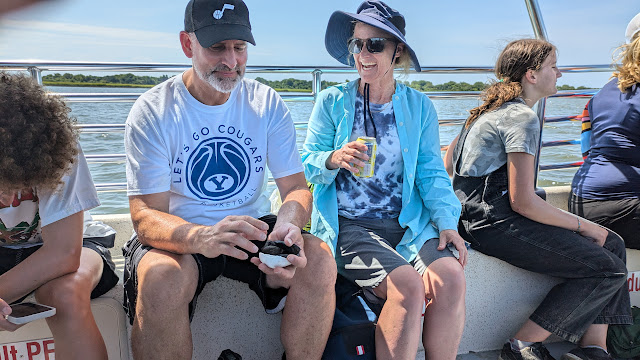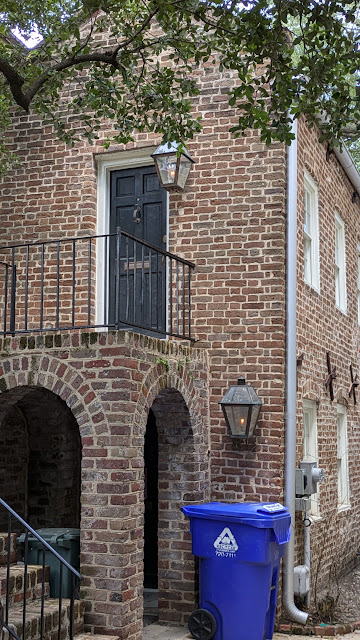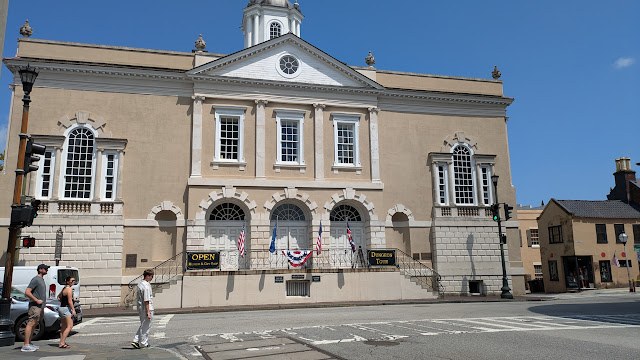Charleston, South Carolina, our post Schweinitz reunion trip
Last evening of our Salem, North Carolina Schweinitz reunion. Goodbye to new and old friends from Germany, Austria, England, US It was a long drive from Winston-Salem to Charleston so we (Ken, Emily, Aaron, Andrew, Lucie Taylor, Julius von Schweinitz :cousin from Vienna and next year's reunion in Vienna organizer, and I) were glad to enjoy the evening on the waterfront by the old French quarter. SC is very hot and humid, so everyone was out in the evening to enjoy a little cooler air.
The pineapple is the symbol of hospitality. Sailors would place one on their doorstep to welcome a visit from those they had not seen for awhile.
Even a mariachi band to celebrate a marriage proposal
Monday morning we drove to Mount Pleasant to the east of the bay to visit Boone Hall, a beautiful plantation with a sobering history. It was founded in 1681 and saw 5 generations until 1811. The current owners,
the MacRaes have owned it since 1955, and have greatly renovated the house. These southern live oaks can live 500-700 years.
Rice and indigo and then cotton were the main crops. With the invention of the cotton gin, there was a huge need to increase the slave labor for picking. These important export mostly . to Britain crops were replaced by pecans (largest producers in the US), which take 14 years to produce. From 1619-1816, 40% of the slaves from Africa, especially from Angola and today's DRC, arrived in Charleston. These crops and the skills and labor of slaves made Carolina home to the richest families on the American continent. The Boones supplied timber from trees in the forests to other colonies for ship building, etc., and traded deer skins they bought from native Americans in exchange for guns, axes, cooking pots.
The Spanish moss, not really moss, but a bromeliad, called oka or tree hair by some! It was used to fill mattresses, etc.We listened to the fascinating history of the Gullah (African conglomerate of peoples from many countries) told and sung/rapped by a lovely Gullah woman. Many pooled their money, bought land and stayed after the end of the Civil War.
Music was not for entertainment, but a way of life, to identify tribes (most were from West Africa), to transmit coded messages to help the enslaved escape. Escapees tied branches to their feet to brush away their tracks. Instruments, especially drums were banned, so chants and songs were key. The Gullah made, and still make, and sell beautiful sweet grass baskets. Our friend and relative Johnnie Mae de Schweinitz (who attended our Salem reunion the week before) is descended from a Gullah man, Robert Smalls, whose owner taught him to read and write, not to plant. He learned the waterways and handled boats, and eventually was able to commandeer one, the CSSPlanter, to escape with his own and other wives and children and come over to the Union, where he fought in 17 battles! He served 5 terms in the House of Representatives!
Each restored slave cabin had a theme. One portrayed important events and leaders of the Civil Rights movement.
As we waited that afternoon for our boat ride to Fort Sumter, we looked at the exhibit of slaves who died in the Gadsen (owner of slave wharf) harbor, where they were sold; later sold on street corners until slave houses for selling were mandated in 1780. Until the importation of slaves was abolished in 1808, 200,000 men women and children were sold from Africa and the Caribbean.
Monday was Lucie's 14th birthday. After a spicy Thai dinner we attended a fun audience participation play (comedy) at the Black Fedora (small theater in Charleston). Ken, Emily, Andrew and Aaron were amazingly funny actors (given a script, investigating a murder!)
The next morning we got up early, drove to Morris Island where we took a boat to find small black sharks' teeth fossils in the sand!
In the afternoon the others went crabbing (by boat) while I took a private (no one else signed up, so I was lucky my very nice and knowledgeable guide Faith Rose did not cancel) tour of the old quarter. Above is the entrance to the large old market.
One of three fire towers built after the earthquake of 1886
St Philips Anglican church (1723). It was Anglican, the only churches paid for by taxes. All other denominations, except Catholics, were allowed to build/worship, but had to fund themselves. No building can be taller than 5 stories (houses 3) in the historic district which was within the old walls. Each street ended in a dock.

The French Huguenot Church built in 1687, rebuilt in 1845 in Gothic style.
The beautiful Dock Street Theater, the first theater in America. Speaking of theaters, Abraham Lincoln was supposed to be in Charleston that night in 1865, instead of in the Booth Theater where he was shot.
The pink (oldest ) house (1713), a tavern originally. About 1/4-1/3 of the buildings were taverns. It was built of 18" thick imported stone.
The Exchange building (1771) sold timber, rice, indigo on the first floor; the lower floor was for storage and only later did the British take it over as a dungeon.
President George Washington visited Charleston for 8 days in 1791, giving the city a painting of Trumble's "Signing of the Declaration of Independence." Trumble sent them "GW in Trenton." They wanted him to paint GW in Charleston, so the painter mockingly painted a tiny city between the legs of his __ horse! It was called "Trumble's Revenge" for their ingratitude!
The beautiful "Rainbow Row" houses, with bottom floor for merchants' offices (they were across from the wharves), upper floors were homes. They became slums until realtor Susan Pringle Frost bought them for 5 cents a square foot in 1925, and ladies went to the city council and had them refurbished. Today they are on landfill (once the moat around the city wall)
Charleston, St. Augustine in Florida and Quebec City, were the only walled cities in America, needed to defend against the British and the Spanish. The Charleston sea wall was built in 1820. It enclosed 62 acres.
Charleston, St. Augustine in Florida and Quebec City, were the only walled cities in America, needed to defend against the British and the Spanish. The Charleston sea wall was built in 1820. It enclosed 62 acres.
Good homes all had piazzas, used as sleeping and resting porches. The front door did not go into the main house but into the piazza. If the door was open, guests were welcome, if closed, passersby were not even supposed to look at the home.
St, Matthews Lutheran church 1840 is to be the tallest building in the old part of the city
A detached kitchen (required after earthquake fires)
The circular Congregational church on Meeting Street . I then went to market and bought some pictures and tablecloths while waiting for the crabbers to pick me up!
We ate lunch at a great restaurant (Coleman Public House), took Julius to the hotel where he would stay a few more days, went to the small Charleston airport for our 6 pm flight. We got home to Provo at midnight.
End of a very interesting week.Now back to hot but dry Utah with
St, Matthews Lutheran church 1840 is to be the tallest building in the old part of the city
A detached kitchen (required after earthquake fires)
The circular Congregational church on Meeting Street . I then went to market and bought some pictures and tablecloths while waiting for the crabbers to pick me up!
The last day we drove to Edisto Island (far left on the map), which was extremely hot and humid. With climate change, the coast has eroded leaving many uprooted trees, shells, and crabs.
We ate lunch at a great restaurant (Coleman Public House), took Julius to the hotel where he would stay a few more days, went to the small Charleston airport for our 6 pm flight. We got home to Provo at midnight.
End of a very interesting week.Now back to hot but dry Utah with
lots of memories









































































No comments:
Post a Comment